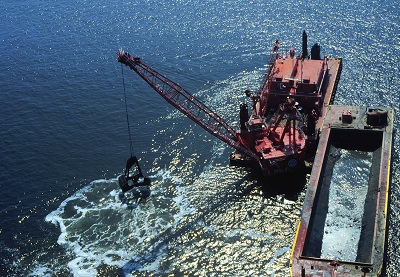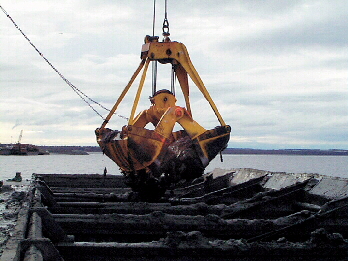MPRSA Dredged Material Permits
In the United States, uncontaminated dredged material is the primary material permitted by the MPRSA today. Dredged material is sediment excavated or otherwise removed from the bottoms of the navigable waters of the United States to maintain navigation channels, ports, harbors and marinas.
Permits and Federal Projects Involving Dredged Material
Under section 103 of the Marine Protection, Research and Sanctuaries Act (MPRSA), the U.S. Army Corps of Engineers (USACE) is the federal agency that decides whether to issue a permit authorizing the disposition of dredged materials into the ocean. In the case of federal navigation projects, the USACE may implement the MPRSA directly in the USACE projects involving dredged materials. The USACE relies on the EPA’s marine protection criteria when evaluating permit requests for (and implementing federal projects involving) the transportation of dredged material for the purpose of dumping it into ocean waters. MPRSA permits and federal projects involving dredged material are subject to the EPA's review and concurrence.
According to the USACE regulations (33 CFR 325.6), MPRSA permits for, and federal projects involving, the transportation of dredged material for the purpose of dumping it into ocean waters may not exceed three years.
MPRSA Ocean Sites for Dredged Material Permits and Federal Projects Involving Dredged Materials

Permitting dredged material under the MPRSA requires the identification and designation of a site where materials may be released. MPRSA ocean sites are precise geographic areas within which activities permitted under the MPRSA can be conducted subject to specific conditions in individual MPRSA permits. Site designations are based on environmental studies of each site and regions adjacent to the site, and on historical knowledge regarding the effects of the material released in areas similar to such sites in physical, chemical and biological characteristics. Please see MPRSA Ocean Site Designation for more information about the site designation process.
For more information about the disposition of dredged material into the ocean, including information on MPRSA ocean sites, please visit the U.S. Army Corps of Engineers Ocean Disposal Database.
Process for Obtaining an MPRSA Permit for Dredged Material

The USACE District Offices are responsible for coordination of all federal actions, including the EPA's concurrences, pertaining to MPRSA section 103 applications (permit applications for dredged material). All MPRSA section 103 applications are coordinated with the appropriate EPA Regional Office. For a list of the EPA's Regional contacts, please see our Marine Protection Permitting Program Contacts web page.
The process for obtaining an MPRSA permit for dredged material typically lasts between six to 18 months after application. Before applying, applicants are encouraged to contact the local USACE District to meet with the USACE and the EPA in order to fully understand the process and requirements for obtaining the permit. The EPA does not concur on a proposed permit unless the proposed dredged material has been shown to meet the marine protection criteria. The EPA’s marine protection criteria consider, among other things:
- the need for the activity;
- the environmental impact of the activity, including its effect on marine ecosystems, shorelines and beaches;
- the effect of the activity on esthetic, recreational or economic values;
- the adverse effect of the activity on other uses of the ocean including navigation, scientific study, fishing and resource exploitation activities; and
- land-based alternatives to the activity.
The EPA’s marine protection criteria are published at 40 CFR 220-229. The EPA may concur with or without conditions or decline to concur on the permit, i.e. non-concur. If the EPA concurs with conditions, the final permit must include those conditions. If the EPA declines to concur (non-concurs) on an MPRSA permit for dredged material, the USACE cannot issue the permit. Data requirements for ensuring this compliance can be extensive. The permit process is outlined below and consists of the following general steps:
- Pre-application Consultation: Includes discussion of alternatives to minimize volume of material proposed to be permitted under the MPRSA, including potential beneficial uses of the dredged material (e.g., sand for beach nourishment or fine grain sediments for marsh restoration), and the information and testing required to evaluate the proposed dredged material.
- Evaluation of Dredged Material Proposed for Ocean Disposal: Includes development, approval and implementation of a sampling and analysis plan and an assessment of compliance with the marine protection criteria. To learn more about how dredged material is evaluated, please visit our Testing and Evaluation web page.
- Permit Application: 33 CFR 325.1 (pdf) describes the requirements of the permit application under the MPRSA. In addition, the application should include:
- an evaluation of dredged material disposal alternatives including an examination of potential beneficial uses of the proposed dredged material;
- written documentation of the site dredging history and a general survey of other prior or current dredging activities at or near the site; and
- references to existing or prior MPRSA Section 103 permits.
- Review of Application for Completeness: Additional information is requested if the application is incomplete.
- Issuance of Public Notice by District: Public Notices must include all of the information required in 33 CFR 325.3(a).
- Evaluation and Review includes, but is not limited to:
- Public interest review: the USACE District considers all comments and incorporates them into the administrative record associated with the application.
- Evaluation and determination by USACE District Engineer.
- The EPA's review: the EPA has 30 days to request additional information it deems necessary to evaluate the proposed permit. the EPA has 45 days with an optional additional 45-day extension to review the information, to evaluate the proposed permit, to determine compliance with the ocean dumping criteria, and to respond in writing on the proposed permit. The EPA may concur with or without conditions or decline to concur on the permit. If the EPA concurs with conditions, the final permit must include those conditions. If the EPA declines to concur (i.e., non-concurs), the USACE cannot issue the permit.
- Permit Issued or Denied: A decision to issue or deny a permit is discussed in either a Statement of Findings or Record of Decision and the final decision (i.e., a permit or a denial) is issued.
